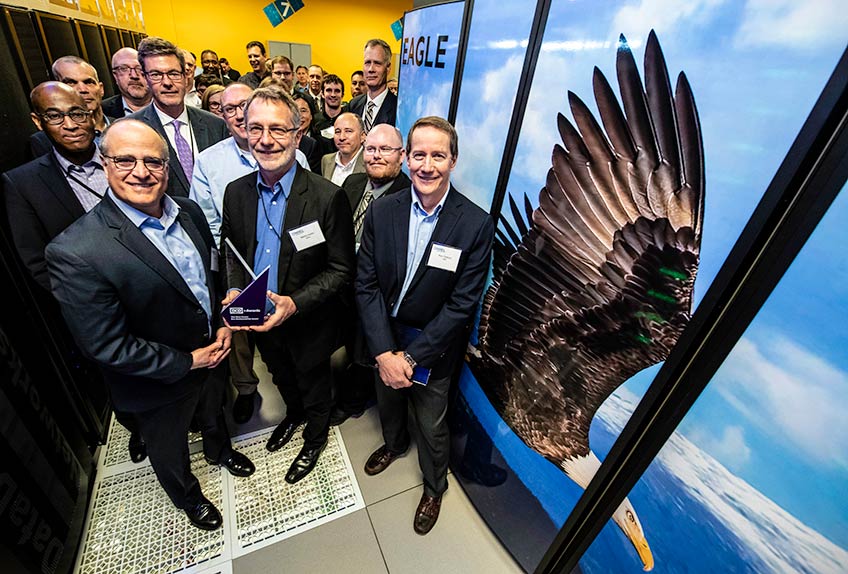NREL's New Supercomputer, Eagle, Takes Flight
Now in production use, the ultra-efficient Eagle high-performance computer will power scientific insights to accelerate our energy system transformation.
The U.S. Department of Energy’s (DOE’s) National Renewable Energy Laboratory (NREL) already had the world’s largest supercomputer dedicated to energy efficiency and renewable energy, Peregrine—but with its replacement system, Eagle, the laboratory’s computing capability has more than tripled. This means considerably more power to help NREL scientists advance R&D across the spectrum of renewable energy and energy-efficiency technologies.

Partners from HPE joined NREL and DOE to celebrate NREL's new 8.0-petaflop supercomputer, capable of carrying out 8 million-billion calculations per second. Photo by Dennis Schroeder/NREL
The new system is the latest development in a long-standing partnership between Hewlett Packard Enterprise (HPE) and NREL to find innovative and energy-efficient supercomputing solutions. Representatives from HPE joined NREL and DOE to celebrate the new system at a Jan. 8 ceremony at NREL’s Energy Systems Integration Facility (ESIF), which commemorated the official launch of Eagle for production use.
Not only does Eagle (with a peak performance of 8.0 petaflops, meaning it can carry out 8 million-billion calculations per second) drastically increase NREL’s computing capability for renewable energy and energy-efficiency research—the system itself is energy efficient, too.
Eagle features a warm-water liquid-cooled design that was originally developed for Peregrine in partnership with HPE—a concept that has become standard for other data centers. The system is designed to capture 97% of the supercomputer’s waste heat, which can then be made available for use throughout the building in which the system is housed. At the ESIF, the heat captured from Peregrine and Eagle is reused in office and lab space.
The successful demonstration of this innovative approach has led, in part, to two recent honors for the ESIF data center: a Federal Energy and Water Management Award and the prestigious 2018 Data Center Dynamics Data Center Eco-Sustainability Award.
“This is a really exciting time for high-performance computing at NREL,” said Computational Science Director Steve Hammond. “The global recognition our data center is receiving cements its position as the most energy-efficient data center in the world. And now, with Eagle up and running, we’re poised to deliver more scientific insights than ever before to advance our nation’s energy transformation.”
Watch a time-lapse video of Eagle “settling into its nest” and learn more about NREL’s computational science capabilities and facilities on nrel.gov.
Last Updated May 28, 2025
